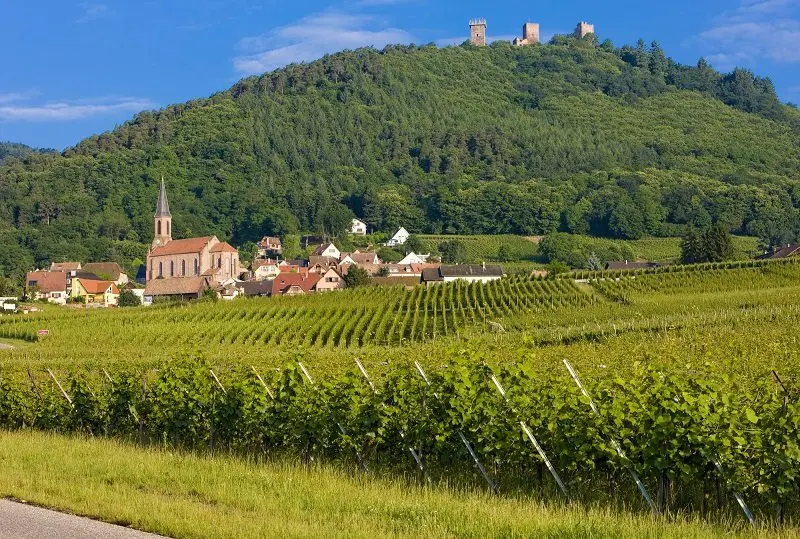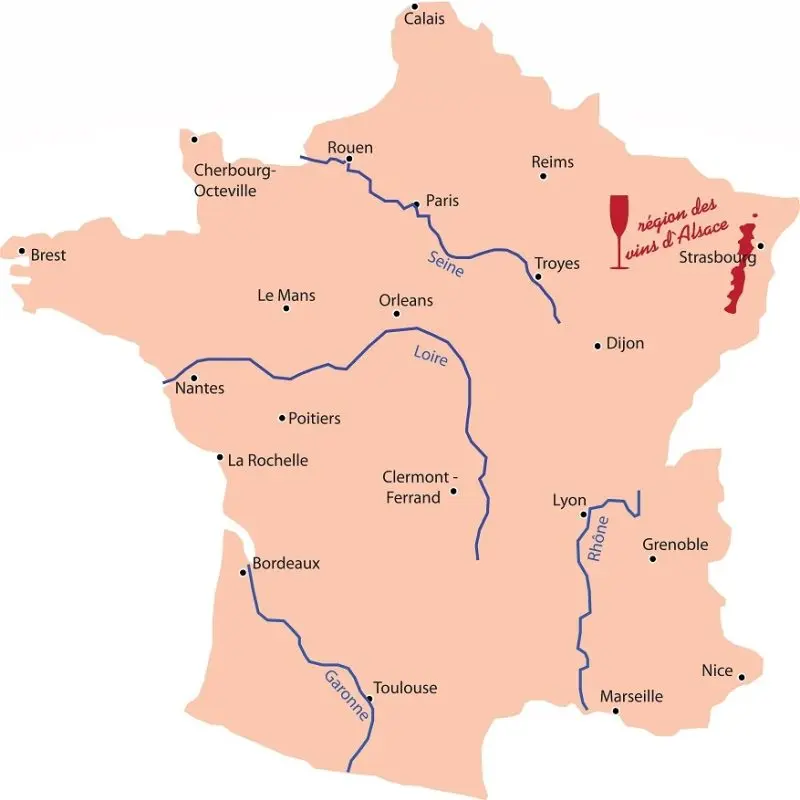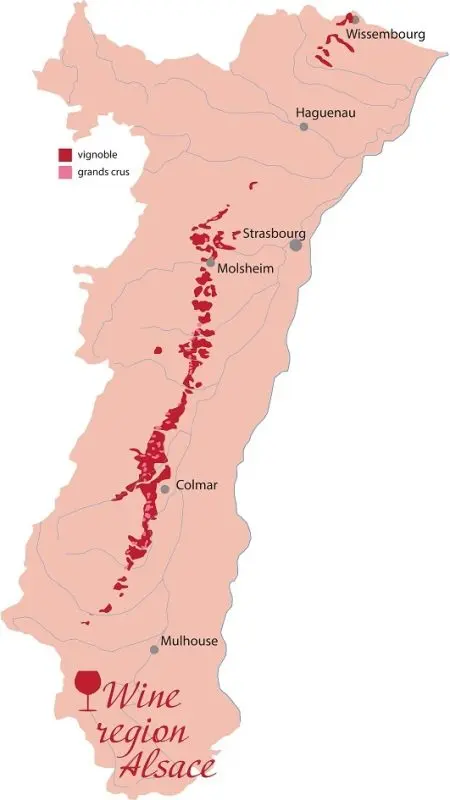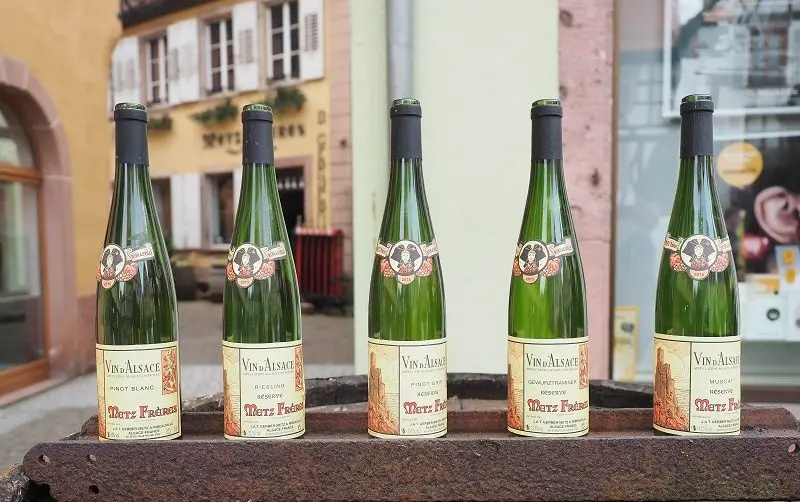Contents
Alsace is a historical region between France and Germany, alternately passing under the dominion of one or the other country. Since 1945, it has been a French territory, but it has retained many German traditions. That is why Alsatian wines are mainly made from varieties that are more characteristic of Germany. It is in Alsace that one can find some of the best examples of Riesling and Gewürztraminer.
Statistics
In 2006, the region produced more than 111 million liters of wine, more than 15 thousand hectares were allocated for vineyards, and 119 villages were employed in production. 78% of the vineyards were AOC Alsace, 4% AOC Alsace Grand Cru and the remaining 18% AOC Crémant d’Alsace. About 25% of all production went for export. The main importers of Alsatian wines are Belgium, the Netherlands, Germany, Denmark, and the USA.
History
The constantly changing “nationality” of the region had a huge impact on the development of local winemaking. After the Second World War, Alsace began to produce mostly dry wines that go well with hearty dishes. The region has taken a course on quality – almost every wine produced here has AOC status.
In Alsace, there are no Vin de pays (lower quality wines labeled not by appellation, but by production villages). The only exception is that occasionally you can find table wine, which does not indicate the grape variety, locality and vintage, but the share of such products does not exceed a couple of percent. Since 1983, local winemakers have begun to produce sweet and even dessert wines, but their percentage is minimal.
An interesting fact: until 1993, Tokay d’Alsace wine was produced in Alsace. Unlike the Hungarian counterpart, the drink was made from Pinot Gris, not Furmint. Now “Tokay” is a name protected by origin, which can only be assigned to Hungarian wine.
Features of the region
In the west of Alsace are the Vosges Mountains, in the east – the Rhine River. The vineyards are located on the eastern, southwestern and southeastern slopes of the mountains at an altitude of 175-420 m above sea level. Due to the natural protection from wind and rain, Alsace is quite dry and sunny.

Grape varieties
The following varieties are cultivated in Alsace: Riesling, Gewürztraminer, Pinot Gris, Auxerrois Blanc, Pinot Noir, Sylvaner, Pinot Blanc, Muscat, Chasselas, Chardonnay, Sauvignon.
The region boasts a wide variety of soils and terroirs.
Alsace wine classification
Almost all Alsace wines are monovarietal whites (~90%), with the exception of samples made from Pinot Noir, they are red or pink. Sparkling cremant is also made in the region.
Appellations
- AOC Alsace. The entire region is labeled with wines made from one variety.
- AOC Alsace Grand Cru. This appellation includes 51 terroirs. Only wines made from four grape varieties (Riesling, Pinot Gris, Gewürztraminer, Muscat) are handpicked and receive the label.
- AOC Cremant d’Alsace. Sparkling wines “cremant” from Pinot Gris, Pinot Blanc, Riesling, Pinot Noir, Chardonnay.


Styles and characteristics of wines
White wines are distinguished by a rich bouquet, fragrant floral aroma with tones of peach and slight sourness. Manufacturers try to avoid aging in oak so that spicy notes do not appear in the bouquet.
Traditionally, Alsace was famous for dry wines, but now some winemakers are experimenting with residual sugar, supplying semi-dry and even semi-sweet examples to the market. This information is rarely listed on the label, so consumers should be careful: Gewürztraminer and Pinot Gris may be “sweet”, while Riesling, Muscat and Sylvaner will most likely be dry.
In Alsace, it is customary to make wines 100% from one grape variety, but this is not a strict rule, there are blends. Such wines are called Edelzwicker (Edelzwicker, a blend of any white varieties in any proportion without being indicated on the label) and Gentil (Gentil, a blend of different varieties, but from the same estate).
Alsatian wines are marketed in characteristic tall and narrow bottles, known as “Alsace flute” (flûtes d’Alsace), although the official name specified in the AOC rules is vin du Rhin, i.e. “Rhine bottle”. However, such a bottle can also be found outside the region, especially Riesling and other traditional white wines are poured into it.

Late harvest wines
There are two types of “late harvest” wines:
- VT (Vendange Tardive, “late harvest”). It is made from very ripe, sun-dried berries, picked in late November – early December from the best vines.
- SGN (Selection de Grains Nobles, “selected noble berries”). Wine made from berries affected by the “noble” mold Botrytis Cinerea.
Alsatian wines in both categories are slightly stronger and drier than their counterparts from other regions.
Main single varietal wines
Riesling (Riesling). Light yellow wine with green reflections. Aroma: Lemon, lemongrass, grapefruit, peach, pear, fruit compote, white flowers, lime blossom, nettle flowers, anise, licorice, fennel seeds, mineral notes. Riesling can “ripen” in the bottle for several decades, becoming only more aromatic.
Pinot Blanc (Pinot Blanc). Light golden light-bodied wine. Aroma: fresh, fruity, with notes of peach, apple, flowers.
Sylvaner (нем. Silvaner или Sylvaner). Almost transparent wine with a green tint. Aroma: sourish, fresh, with tones of citrus, white flowers, freshly cut grass.
Muscat (fr. muscat, from lat. muscus – musk). Bright yellow wine with a pronounced grape aroma. It has a “velvet” texture and a balanced bouquet. Not to be confused with the sweet Muscat produced in the south of France!
Famous brands of Alsace wines
Popular brands: Maison Trimbach, Domaine Zind-Humbrecht, Hugel & Fils, Léon Beyer, Weinbach, Josmeyer, Marcel Deiss, Paul Blanck, Ostertag, Pfaffenheim, etc.
How and with what to drink Alsatian wines
Balanced and fresh wines of Alsace are combined with almost any cuisine: spicy Asian, simple American, refined French.
Riesling is a gastronomic pair with fish and seafood, Pinot Blanc – with light snacks and salads, Gewurztraminer – with aromatic cheeses, Pinot Gris – with mushroom risotto, Muscat – with vegetables, Kreman – with nuts, fruits, hard cheeses.

Any of these wines can be served with poultry, lean veal, rabbit meat.









